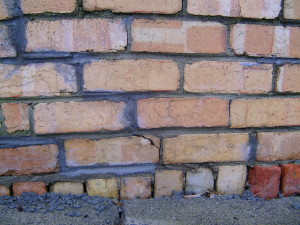Building On Clay Soils
Clay is a fairly common soil type.
Although it is quite suitable for building one issue is that some types of clays (‘Reactive’ or ‘Desicated’ clay) that shrink or swell depending on the level of moisture.
This can lead to the following problems:
Subsidence
Subsidence or settlement is when the building foundation drops, caused by the loss of support of the site beneath the foundations.
This is usually caused by shrinkage of the clay due to it becoming drier.
Typically this is due to tree roots spreading under the building and taking the moisture out of the clay.
Prolonged drought can also cause soil shrinkage beneath a building.
Soil Heave
Heave is the expansion of the ground beneath part or all of the building.
Expansion pushes the foundations, and thus the building upwards.
This is a photo of a boundary wall with inadequate foundations.
Due to soil heave the right side of the wall has lifted by over 100mm causing cracking of the mortar joints, and a brick.
Although the mortar joints have recently been repointed you can see they are no longer straight.
The most common cause of soil heave is building is when the clay becomes wetter and starts to expand.
Common reasons for the clay to become wetter are:
- Water seeping down the side of the house (In areas of reactive soil a normal requirement is to have a 1m wide footpath round the house)
- Poor site drainage (No drainage, blocked drains, or leaking water pipes)
- Removal of trees (This means the drying effect of the roots has been removed)
A couple of danger signs of future soil heave issues for a new house build are:
- If building after several years of drought the soil may be excessively dry and therefore more likely to become wetter when the drought breaks.
- Removal of trees immediately before building.
Summary
There is no reason why you shouldn’t build on clay soils but you need to ensure that;
- You have chosen an appropriate construction method (Brick Veneer is usually better than double brick)
- There will be minimal soil moisture change when the house is built. (see this link: Protecting Your Slab)
- If you need concrete piers see the following link: Building on Fill.
To find out more about the soil on your block click on this link: Soil Classification
Lots more information in the anewhouse at this link: Guide to Buying a Block
To find out what soil is on your block see this link: Site Investigation